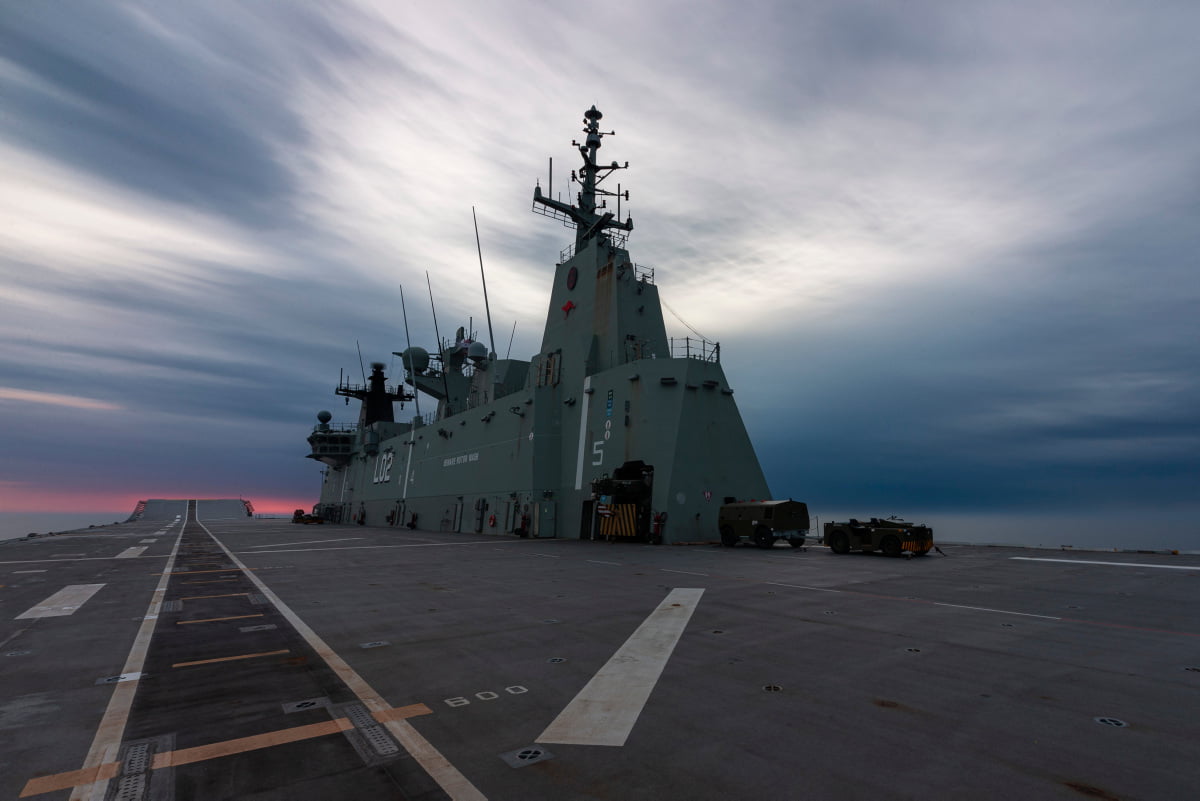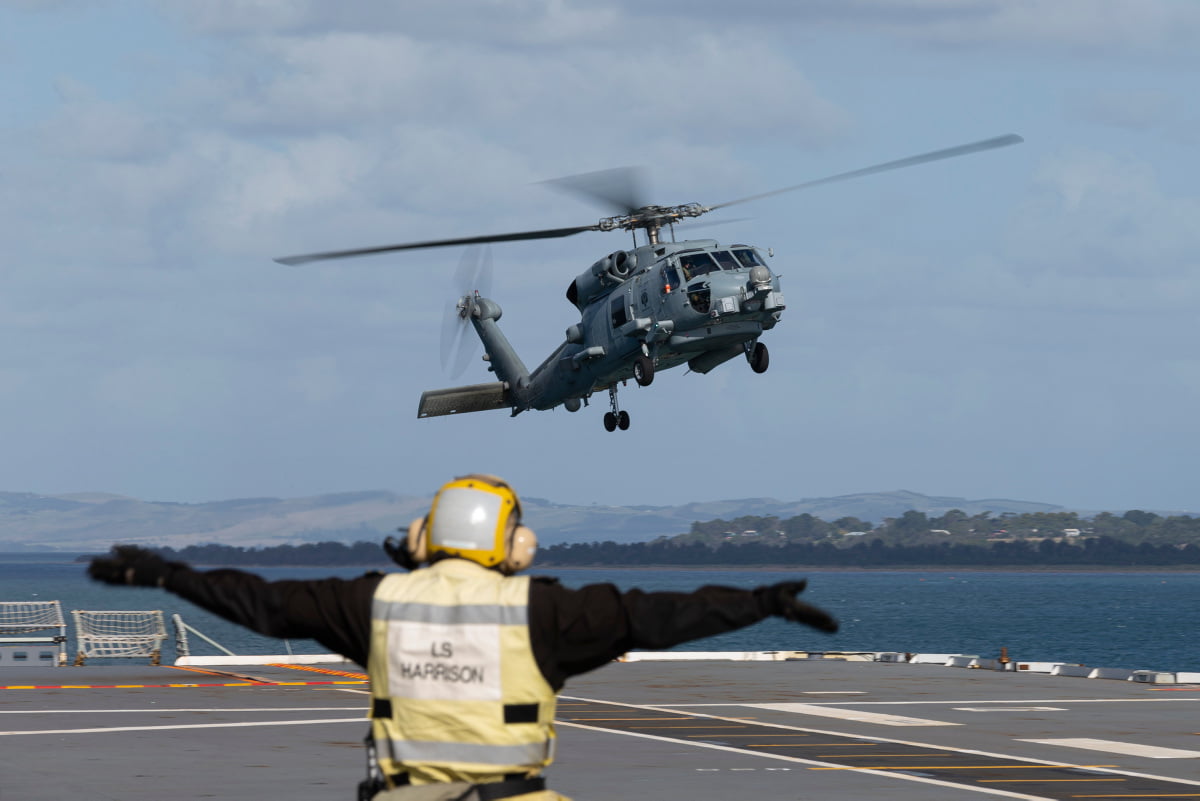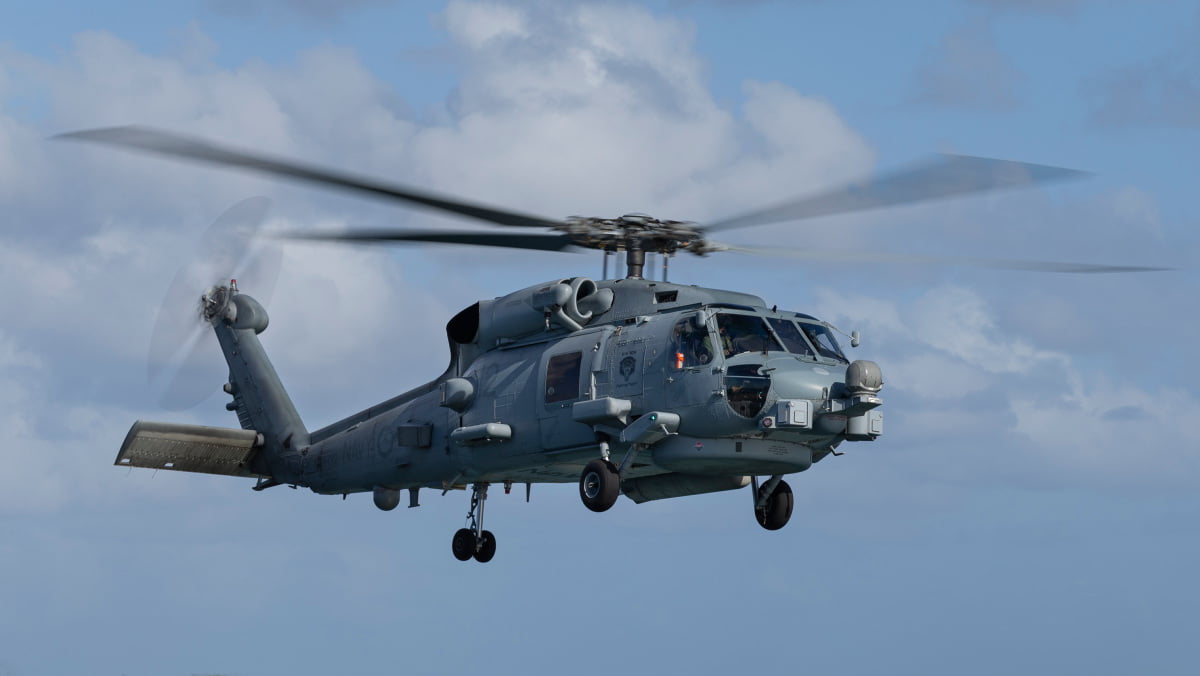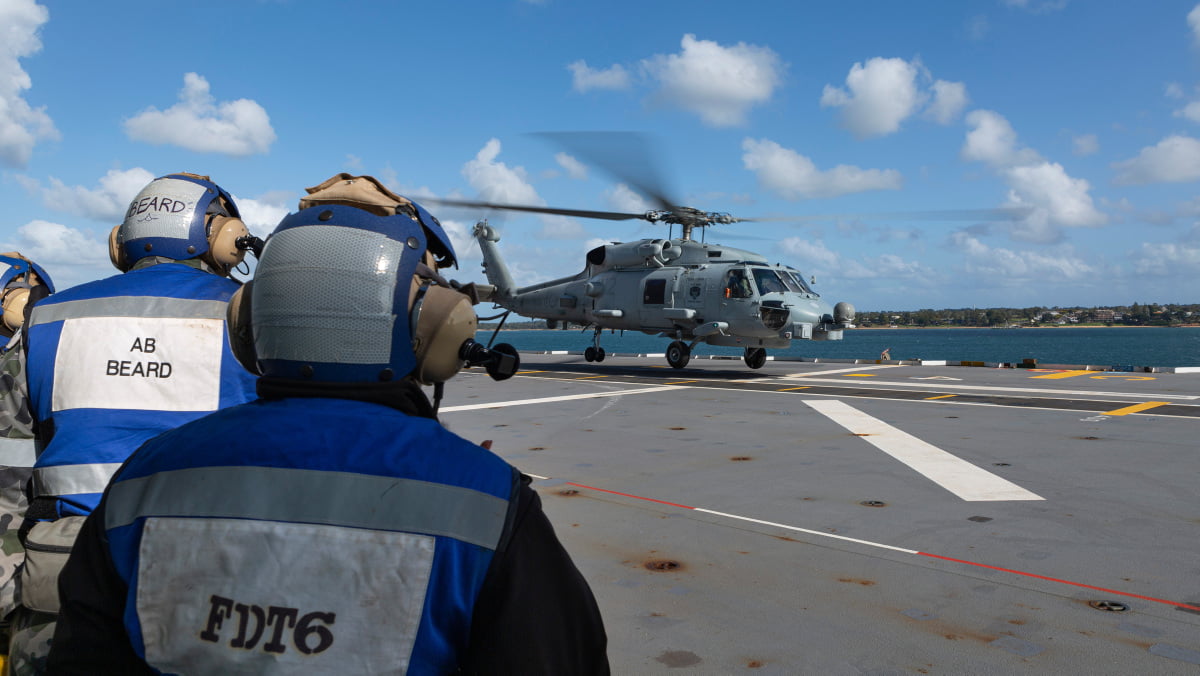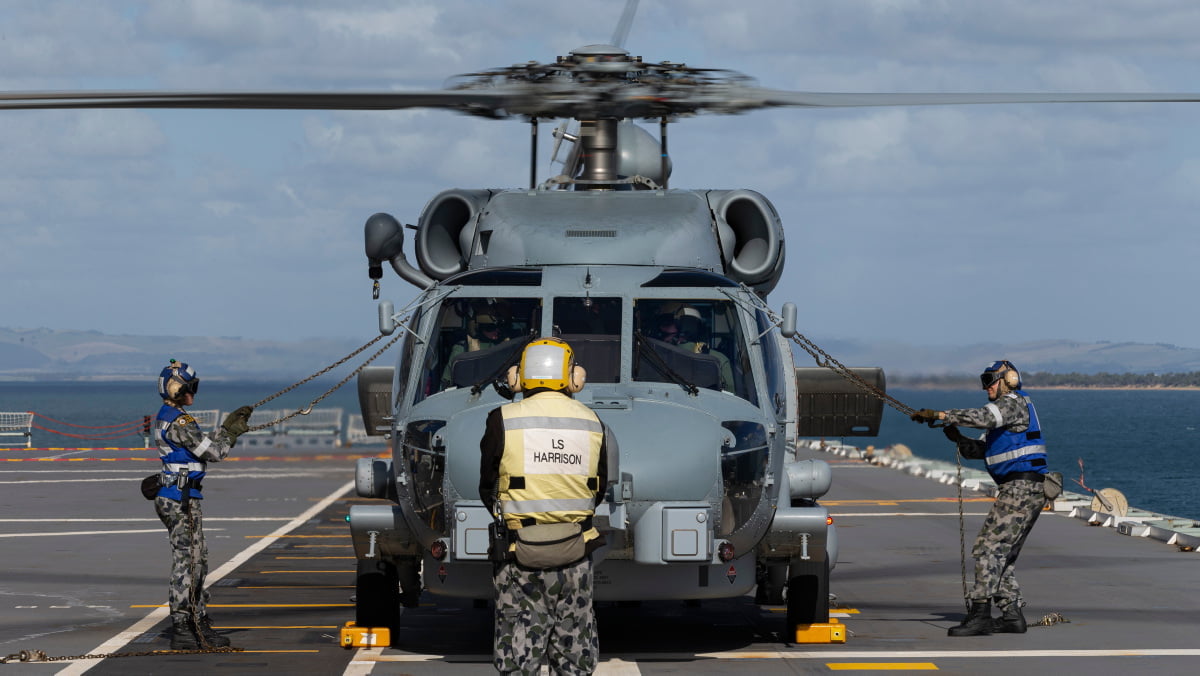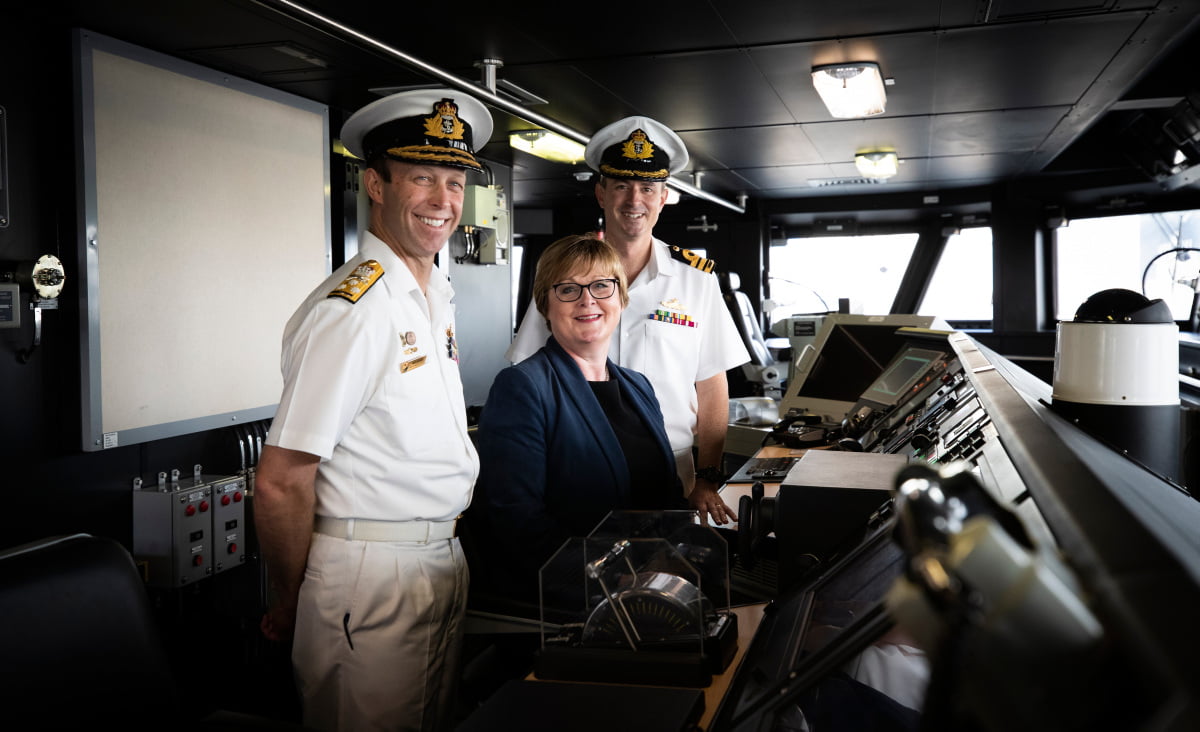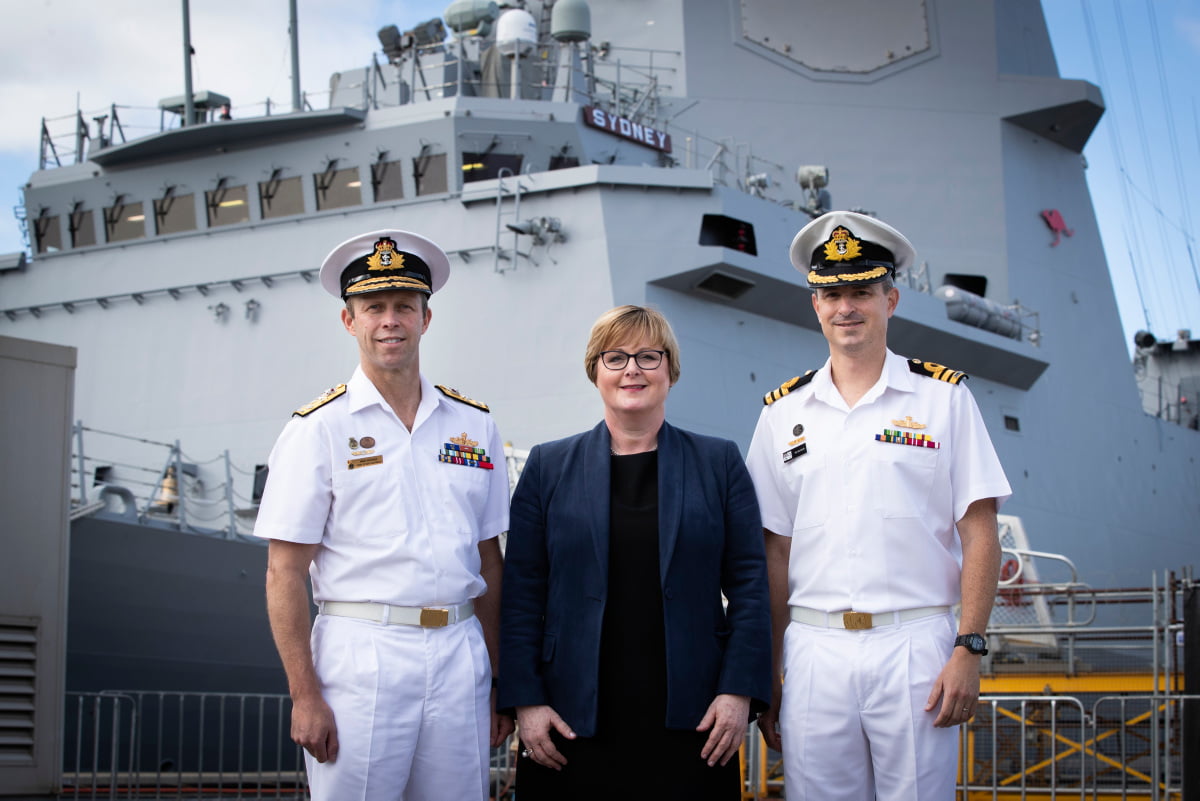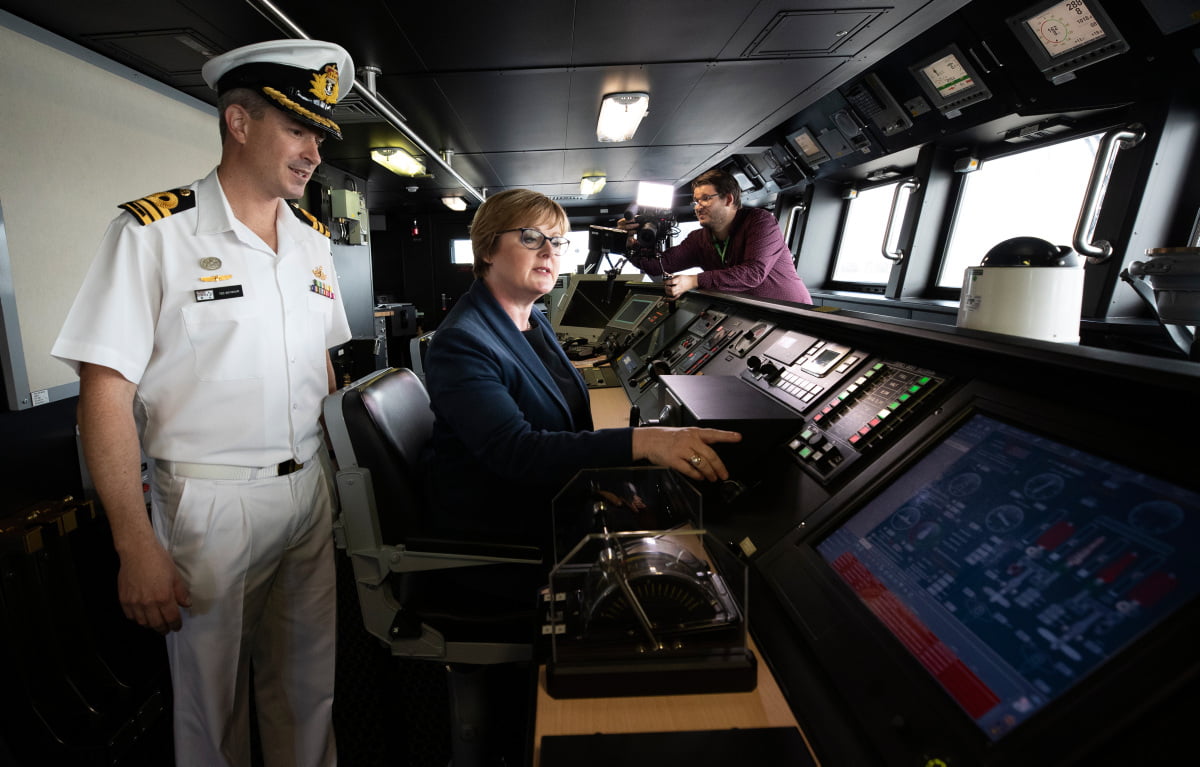By Robbin Laird
On February 28, 2020, the final of three Air Warfare destroyers was handed over officially to the Royal Australian Navy.
NUSHIP Sydney is the final of the three ships being delivered by the Air Warfare Destroyer Alliance, which includes the Department of Defence, Raytheon Australia, and ASC Shipbuilding supported by Navantia Australia.
Minister for Defence Linda Reynolds attended the acceptance ceremony at the Osborne Naval Shipyard in Adelaide.
“While the delivery of NUSHIP Sydney marks the end of this program, it represents an exciting time for the National Naval Shipbuilding Enterprise, as we continue to build upon the unique skills developed at this precinct and transfer them across the whole shipbuilding ecosystem,” Minister Reynolds said.
“I congratulate the 5000 workers who have worked directly on this program over the past decade, from the design phase through to the construction, integration and delivery of these magnificent ships.
“The significance of this success cannot be understated and is reflected in the truly world-class capability of these warships, and the naval shipbuilding and combat system integration skills that have been developed at Osborne.”
NUSHIP Sydney will now sail to her home port at Garden Island in Sydney and, once commissioned later this year, will join HMA Ships Hobart and Brisbane to complete Navy’s new fleet of its most capable warships to date.
And in an August 6, 2018, I reported on a visit and interview with the Captain of the first of the Air Warfare destroyer. That article follows:
The HMAS Hobart is the first of the three Aegis Air Warfare destroyers to be operational with the Navy and the second ship will be commissioned later this year.
The ship introduces a new level of combat capability into the Royal Australian Navy in which the ship’s reach is significantly greater than any previous ship operational in the Aussie fleet because of its Aegis Combat system.
It is a key building block in shaping an integrated air-sea task force navy in that the capabilities onboard the ship can contribute to an integrated C2, ISR and strike grid in which the evolving capabilities of the ADF can cover a wider area of operation in the waters surrounding Australia or in service of missions further abroad.
As Rear Admiral Mayer noted during an interview conducted with him while he was Commander of the Australian fleet:
“We are joint by necessity.
“Unlike the US Navy, we do not have our own air force or our own army. Joint is not a theological choice, it’s an operational necessity.”
What clearly this means is that the future of the Hobart class is working ways to operate in an integrated battlespace with land-based RAAF F-35s, Tritons and P-8s among other air assets.
Their future is not protecting the carrier battle group, as the Aussies have no carrier.
Rather, their future is “to provide air defence for accompanying ships in addition to land forces and infrastructure in coastal areas, and for self-protection against missiles and aircraft.”
The skill sets being learned to operate the ship, notably the workflow on board the ship, in terms of the use of data, ISR and C2 systems, working situational awareness throughout the work stations onboard the ship, are foundational for other ships coming to the fleet.
With the coming of the Brisbane, the HMAS Hobart will no longer be a single ship but the lead into a class of ships.
And with the Australian decision with regard to its new frigates which will leverage the Aegis combat system capability as well, the HMAS Hobart has become the lead into a whole new approach to how the Australian fleet will shape its combat networks as well.
This means that the training and support provided to HMAS Hobart is a foundation for a larger effort for the Navy as well.
And with the addition of F-35 as well as P-8s and Tritons as well as the evolution of the KC-30A tanker, the fleet looks to become a core element for an integrated air-maritime task force approach.
Indeed, when visiting HMAS Hobart one can already see crew from the Brisbane onboard getting ready for its initial deployments as well.
The Aegis combat system pioneered by the US Navy and Lockheed Martin has become a global capability as an Aegis Global Enterprise has emerged in which new types of ships have been built carrying variants of the Aegis combat system.
This started with the Japanese becoming the first foreign navy to buy Aegis and then in a critical breakthrough moment, Aegis was sold to the Spanish Navy which built a new type of ship on which to operate Aegis.
I was working for a consulting company supporting the Navy at the time, and was supporting what would become what I coined in the mid-1990s, the Aegis Global Enterprise.
There was opposition both within the US Navy and without to selling Aegis to the Spanish Navy but senior leaders at the time in the Clinton Administration, notably Secretary of Defense Perry, supported the effort.
Working on the issue at the time, I learned a great deal about how a good decision can navigate critics and challenges, and fortunately for the Navy the decision was taken to sell the Aegis combat system to the Spanish.
Much like the F-35 global enterprise, the benefits to allies and the US alike become obvious with the cross-learning and not just from the US to the allies, but among allies as well as from allies to the United States.
The HMAS Hobart is clearly a result of this process.
It is a variant of the Spanish ship and was sold via Spain to Australia.
The senior staff and crew operated on a Spanish frigate last year to get used to the form factor of the ship and could anticipate the workflow as well prior to getting their own ship.
According to an article published last year by the Royal Australian Navy, the time spent onboard the Spanish ship was highlighted.
Captain Stavridis said he and some of his crew members were fortunate to have spent time at sea in their Spanish sister ship, Cristobal Colon (F105), earlier this year.
“The time spent in Cristobal Colon was extremely valuable as it provided a unique opportunity to better understand the platform and to work with a crew that have a detailed working knowledge of the ship,” Captain Stavridis said.
“Cristobal Colon’s crew were extremely generous in their time and ensured that we were given all opportunities to learn as much as we could.”
He said the layout of Cristobal Colon was very similar to the Hobart class.
“In fact the Hobart class was based on the F104 design with modifications taken from the F105.”
(For a look at the Cristobal Colon, see the following:
https://foronaval.com/2018/02/23/visitamos-la-fragata-cristobal-colon-f-105/)
Of course, the US Navy has been working with HMAS Hobart and indeed the ship will leave soon for San Diego for further collaborative efforts.
And as one US Navy officer put it: “We expect to learn a great deal from you as you shape the operations of the Hobart as it is integrated into the Australian fleet.”
This is the key advantage of a global enterprise approach.
We projected that this would be the case if their was the sale to Spain of Aegis.
Now one can walk onboard the reality, namely, the HMAS Hobart.
Appendix: The Air Warfare Destroyer Alliance
The Hobart class is being built by the Air Warfare Destroyer Alliance.
The AWDs are being built for Australia’s specific defence needs and will provide a significant increase in Australia’s defence capabilities.
The AWDs will provide greater protection for ADF personnel by providing air defence for accompanying ships as well as land forces and infrastructure on nearby coastal areas. The AWDs will also provide self-protection against attacking missiles and aircraft.
The Aegis Weapon System incorporating the state-of-the-art phased array radar, AN/ SPY 1D(V), in combination with the SM-2 missile, will provide an advanced air defence system capable of engaging enemy aircraft and missiles at ranges in excess of 150 kilometres.
The AWDs will also carry a MH-60R Seahawk ‘Romeo’ naval combat helicopter for surveillance and response to support key warfare areas. The surface warfare function will include long range anti-ship missiles and a naval gun capable of firing extended range munitions in support of land forces. The AWDs will also be able to conduct Undersea Warfare and will be equipped with modern sonar systems, decoys and surface-launched torpedoes.
Coupled with an array of close-in defensive weapons, all of these capabilities ensure the AWDs have the layered defensive and offensive resources required to win the battle against 21st century conventional and asymmetric threats.
The Defence team is led by the AWD Program Office in the Defence Materiel Organisation (DMO), which retains overall responsibility for the project management and delivery of the three Air Warfare Destroyers. The DMO, through the Minister for Defence, is responsible to the people of Australia to ensure that the future AWDs are delivered to the RAN on time, on budget and to the required capability.
In April 2005 the Australian Government selected Raytheon Australia Pty Ltd as the Combat System – Systems Engineer, and in May 2005 selected ASC AWD Shipbuilder Pty Ltd as the Shipbuilder. ASC and Raytheon Australia join the DMO in forming the AWD Alliance which is now working hard to deliver this cutting edge capability to the Navy.
On 20 June 2007, the Australian Government announced that the Navantia designed F100 had been selected as the basis for Australia’s future Hobart Class AWDs. The F100 ensures tomorrow’s Navy has the best equipment to defend Australia and its national interests.
Australia’s new Air Warfare Destroyers will be named HMAS Hobart, HMAS Brisbane and HMAS Sydney ensuring the three ships reflect a rich history of service.
When the AWDs are delivered to the Royal Australian Navy they will be in service, defending and supporting Australian interests, for more than 30 years. To put this timeframe into perspective, some of the men and women who will serve on the AWDs are not yet born.
https://www.ausawd.com/content.aspx?p=62
Characteristics of the Hobart Class Destroyers
The Hobart Class Air Warfare Destroyer (AWD) will be one of the world’s most capable multi-purpose warships.
In selecting the Navantia-designed F100 as the baseline platform design and coupling it with the Aegis Weapon System, the Australian Government has ensured tomorrow’s Navy has the best equipment to defend Australia and its national interests.
Since entering service with the Spanish Armada, F100s have worked alongside US forces in the Persian Gulf as the first foreign Aegis equipped ships to be fully integrated into a US Navy Carrier Strike Group and have successfully been deployed as the flagship of NATO’s Maritime Group Standing Reaction Force.
The Hobart Class AWDs, which are under constructionat three shipyards in Newcastle (NSW), Williamstown (Victoria) and Osborne (South Australia) will provide air defence for accompanying ships in addition to land forces and infrastructure in coastal areas, and for self-protection against missiles and aircraft.
They will be capable across the full spectrum of joint maritime operations, from area air defence and escort duties, right through to peacetime national tasking and diplomatic missions.
The AWDs’ Hobart Class Combat System, built around the Aegis Weapon System incorporating the state-of-the-art phased array radar, AN/ SPY 1D(V), will provide an advanced air defence system capable of engaging enemy aircraft and missiles at ranges in excess of 150 kilometres.
The AWDs will carry a helicopter for surveillance and response to support key warfare areas. The surface warfare function will include long range anti-ship missiles and a naval gun capable of firing extended range munitions in support of land forces.
They will also be able to conduct Undersea Warfare and will be equipped with modern sonar systems, decoys, surface-launched torpedoes and an array of effective close-in defensive weapons. These capabilities will ensure the AWDs have the layered defensive and offensive resources required to counter conventional and asymmetric threats.
The Hobart Class Combat System will be amongst the most advanced maritime warfare capabilities available and ensure the RAN has unprecedented levels of interoperability with Australia’s allies.
When Australia’s AWDs enter service in the next decade, they’ll be part of a fleet of around 100 Aegis equipped ships operating across the globe and will spearhead a quantum leap in the RAN’s air warfare capability.
https://www.ausawd.com/content.aspx?p=63
The Hobart Class – Differences from the F100 Class
Navantia’s F104 ship design is the basis for the AWD. The F104 baseline is being updated for AWD to include;
Key F105 features,Australian Combat system modifications, and Selected platform upgrades that are unique to the Hobart Class.
These features are summarised as follows:
F105 Modifications
- More efficient and powerful diesel engines coupled with improved fuel tank arrangements will provide increased range,
- The inclusion of a bow thruster will improve manoeuvrability in harbours;
- Improvements to underway replenishment arrangements for manpower efficiencies;
- Changes to funnel tops to improve the ship’s air wake; and
- Bunk size increases to improve habitability.
AWD Combat System Modifications
- The Hobart Class will use the Aegis Weapon System Baseline 7.1and the AN/SPY-1D(V) Phased Array Radar.
- The Under Sea Warfare capability will be upgraded by:
- Enhanced Anti Submarine Warfare capabilities and the addition of a torpedo defence system;
- ASW decoys for torpedo defence;
- Enhanced undersea communications;
- Integration of the MU90 torpedo
Other changes include:
- Modification of the MK45 gun and Gun Fire Control System, including provision for Extended Range Munitions (ERM);
- Addition of the Cooperative Engagement Capability (CEC);
- Modification of the IFF UPX-29 to the current tactical standard;
- Addition of an Horizon Search Radar (HSR) for improved anti-ship missile defence;
- Upgrades to the Surface-to-Surface Missile System to improve target selectivity in congested water, littoral and coastal operations;
- Upgrades to the Very Short Range Defence system to improve its integration and utility against asymmetric surface threats;
- Upgrades to the Electronic Warfare system, including the addition of electronic attack capabilities;
- Addition of X/Ka Satcom and INMARSAT Fleet Broadband and INMARSAT C capability;
- Improved Infrared Search and Track capabilities;
- Improved Electro-Optical Surveillance capability;
- Addition of Nulka Launchers for active missile decoys;
AWD-Unique Platform Modifications
- The ship’s displacement will be increased to 7,000 tonnes for an improved service life margin.
- Cold weather operation will be improved to allow for deployment into Australia’s southern waters.
- The hangar will be modified to accommodate a range of helicopters.
- Other modifications include:
- Increased total cold room capacity for improved endurance;
- Incorporation of a fixed gas detection system to warn of the presence of harmful gases in compartments where personnel exposure risks exist;
- Modification of the 220V/50Hz network to 240V/50 Hz, incorporation of Residual Current Devices (RCD) and the Australian pin configuration for general purpose outlets, and
- Modification of existing stowage, and increases in the overall number of stowage facilities, for thermal protective suit and life raft containers.
https://www.ausawd.com/content.aspx?p=97


